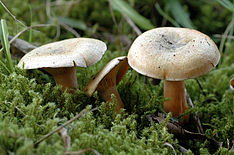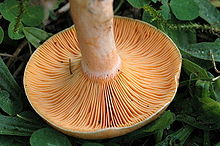- Lactarius glyciosmus
-
Lactarius glyciosmus 
Scientific classification Kingdom: Fungi Division: Basidiomycota Class: Agaricomycetes Order: Russulales Family: Russulaceae Genus: Lactarius Species: L. glyciosmus Binomial name Lactarius glyciosmus
(Fr. ex Fr.) Fr. (1838)Synonyms[1] Agaricus glyciosmus Fr. (1818)
Galorrheus glyciosmus (Fr.) P.Kumm. (1871)
Lactifluus glyciosmus (Fr.) Kuntze (1891)Lactarius glyciosmus Mycological characteristics 
gills on hymenium 
cap is convex 
hymenium is decurrent 
stipe is bare 
spore print is cream 
ecology is mycorrhizal 
edibility: edible Lactarius glyciosmus (commonly known as the coconut scented milk cap[2]) is a semi-edible mushroom in the genus Lactarius. Mycorrhizal, it can be found growing in soil at the base of birch trees in Europe. It is typically coloured a greyish lilac, with the sometimes hollow stem a little lighter coloured than the cap. It has crowded, decurrent gills, and smells strongly of coconuts.
Contents
Taxonomy
Lactarius glyciosmus was initially described by the Swedish mycologist Elias Magnus Fries as Agaricus glyciosmus in 1818. Its specific name is derived from the Ancient Greek words glukos "sugar(y)", and osmos "smell".
Description
L. glyciosmus is a small to medium sized agaric,[2] which typically has a convex cap measuring between 2 and 5.5 centimetres, with a small central depression developing with age. Sometimes there is a central pimple, and the cap is typically coloured a greyish lilac, sometimes varying to a pale buff. It is thin fleshed, with an incurved margin in younger specimens. The stem measures between 25 and 65 milimetres in height, with a width between 4 and 12 milimetres. The cylindical stem is typically widest at the bottom becoming narrower towards the top, or sometimes club-shaped. The stem is concolourous with the cap, but sometimes is a little paler or with a yellowish hue. The stem is particularly soft and easily broken, and can become hollow. The flesh is buff. The gills are decurrent and crowded, and vary in colour from a pale yellowish to a pale flesh, turning to a greyish lilac with age. The milk is white with an initially mild, later hot and acrid taste.[3] The mushroom has a strong smell of coconuts.[2]
It is similar to L. vietus, the grey milk cap, but is differentiated by the fact L. vietus milk dries grey, while L. glyciosmus milk dries white.[4] It can also be confused with L. cocosiolens, which also smells of coconuts, but L. cocosiolens has a slimey brown or orange cap and is not found among birch.[5]
The spore print is a creamy white colour, and the spores themselves are broadly elliptic in shape, and covered with small warts. The warts are connected by thin ridges in an incomplete network.[3] The spores measure between 8 and 9 by between 5 and 6 micrometres.[4]
Edibility
L. glyciosmus is considered edible,[2][3] but is not recommended to the extent that some mycologists consider it inedible.[4] This species is sold in rural markets in Yunnan Province, China.[6]
Distribution and habitat
L. glyciosmus is a common mushroom and is found under broad leaved trees, particularly birch. It can be found between late summer and autumn.[3] It grows in soil individually or in scattered groups.[2] It can be found in North America and Europe,[7] New Zealand,[8] Svalbard,[9] Japan,[10] and China.[6]
See also
References
- ^ "Lactarius glyciosmus (Fr.) Fr. 1838". MycoBank. International Mycological Association. http://www.mycobank.org/MycoTaxo.aspx?Link=T&Rec=120552. Retrieved 2011-06-06.
- ^ a b c d e Jordan, Michael (2004). The Encyclopedia of Fungi of Britain and Europe. Frances Lincoln. p. 304. ISBN 9780711223790. http://books.google.com/books?id=bFMfytLn3bEC&pg=PA304&dq=%22Lactarius+glyciosmus%22&lr=lang_en&as_brr=3&as_pt=ALLTYPES.
- ^ a b c d Phillips, Roger (1981). Mushrooms and other fungi of Britain and Europe. Pan Books. p. 85. ISBN 0330264419.
- ^ a b c Pegler, David M. (1983). Mushrooms and Toadstools. Mitchell Beazley. p. 98. ISBN 9780855335007.
- ^ Kuo, Michael. "Lactarius glyciosmus". MushroomExpert.com. http://www.mushroomexpert.com/lactarius_glyciosmus.html. Retrieved 14 January 2009.
- ^ a b Wang, X-H. (2000). "A taxonomic study on some commercial species in the genus Lactarius (Agaricales) from Yunnan Province, China". Acta Botanica Yunnanica 22(4): 419-427.
- ^ Phillips, Roger. "Lactarius glyciosmus". RogersMushrooms. http://www.rogersmushrooms.com/gallery/DisplayBlock~bid~6233.asp. Retrieved 14 January 2009.
- ^ McNab, RFR. (1971). "The Russulaceae of New Zealand Part I. Lactarius". New Zealand Journal of Botany 9(1): 46-66.
- ^ Ohenoja E. (1971). The larger fungi of Svalbard and their ecology. Annales Universitatis Turkuensis Series A II Biologica-Geographica-Geologica 47: 122-147.
- ^ Murata, Y. (1978). "New records of gill fungi from Hokkaido Japan Part 2". Nippon Kingakukai Kaiho 19(3): 249-254.
Categories:- Lactarius
- Edible fungi
- Fungi described in 1818
- Fungi of Europe
- Fungi of North America
- Fungi of Asia
- Fungi of New Zealand
Wikimedia Foundation. 2010.

